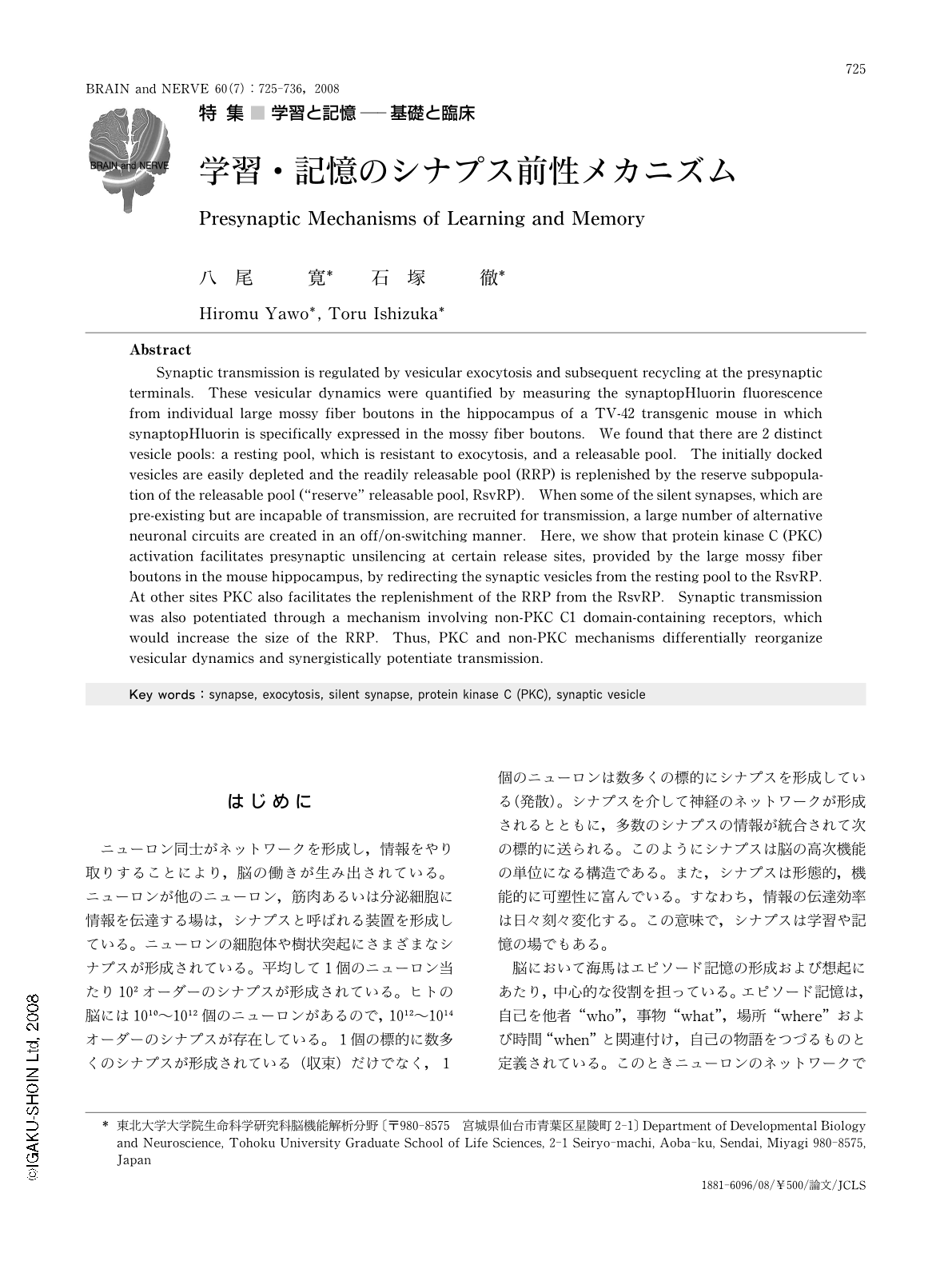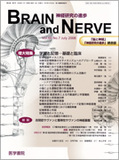Japanese
English
- 有料閲覧
- Abstract 文献概要
- 1ページ目 Look Inside
- 参考文献 Reference
はじめに
ニューロン同士がネットワークを形成し,情報をやり取りすることにより,脳の働きが生み出されている。ニューロンが他のニューロン,筋肉あるいは分泌細胞に情報を伝達する場は,シナプスと呼ばれる装置を形成している。ニューロンの細胞体や樹状突起にさまざまなシナプスが形成されている。平均して1個のニューロン当たり102オーダーのシナプスが形成されている。ヒトの脳には1010~1012個のニューロンがあるので,1012~1014オーダーのシナプスが存在している。1個の標的に数多くのシナプスが形成されている(収束)だけでなく,1個のニューロンは数多くの標的にシナプスを形成している(発散)。シナプスを介して神経のネットワークが形成されるとともに,多数のシナプスの情報が統合されて次の標的に送られる。このようにシナプスは脳の高次機能の単位になる構造である。また,シナプスは形態的,機能的に可塑性に富んでいる。すなわち,情報の伝達効率は日々刻々変化する。この意味で,シナプスは学習や記憶の場でもある。
脳において海馬はエピソード記憶の形成および想起にあたり,中心的な役割を担っている。エピソード記憶は,自己を他者“who”,事物“what”,場所“where”および時間“when”と関連付け,自己の物語をつづるものと定義されている。このときニューロンのネットワークでは,シナプスの強さが変化したり,新しいシナプスが作られたりすることにより,新しい情報の流れが作り出される。Fig.1Aは,海馬における主要なニューロンの作るネットワークの模式図である。ニューロンはいくつかのグループに分けることができるが,それぞれのグループを構成しているニューロン数は,105~107のオーダーであるといわれている。実際のネットワークは三次元的に構成されているが,この模式図では,海馬長軸方向のネットワーク形成に重要な役割を果たしている海馬門苔状細胞(hilar mossy cell:HM)の軸索を省略している。また,抑制性ニューロンの作るネットワークも省略している。海馬への主要な入力は,隣接する大脳皮質側頭葉の嗅内皮質に由来する貫通線維(perforant path:PP)である。貫通線維は,海馬の歯状回の分子層に形成される顆粒細胞(granule cell:GC)の樹状突起やCA1~CA3領域の錐体細胞(pyramidal cell,それぞれ,CA1,CA3と記す),樹状突起の遠位部(網状分子層)にシナプスを形成している。歯状回の顆粒細胞の軸索は,その形態から苔状線維(mossy fiber:MF)と名付けられている。苔状線維は,CA3樹状突起近位部に大型の興奮性シナプスを形成する以外に,苔状細胞や抑制性ニューロンに小型のシナプスを形成している。CA3錐体細胞は,海馬の広範な領域に興奮性の投射をしている。CA3錐体細胞から他のCA3錐体細胞に形成するシナプス(反回性シナプス),CA1錐体細胞に形成するシナプス(シャファー側枝シナプス),左右反対側の海馬に形成するシナプス(交連性シナプス),歯状回内分子層に形成するシナプスなどが主要な回路を形成する。最終的に,CA1錐体細胞の軸索が海馬から大脳皮質への出力になっている。これらの主要なニューロンとそのシナプスからなる層構造が海馬の構造を特徴付けている(Fig.1B,C)。
Abstract
Synaptic transmission is regulated by vesicular exocytosis and subsequent recycling at the presynaptic terminals. These vesicular dynamics were quantified by measuring the synaptopHluorin fluorescence from individual large mossy fiber boutons in the hippocampus of a TV-42 transgenic mouse in which synaptopHluorin is specifically expressed in the mossy fiber boutons. We found that there are 2 distinct vesicle pools: a resting pool, which is resistant to exocytosis, and a releasable pool. The initially docked vesicles are easily depleted and the readily releasable pool (RRP) is replenished by the reserve subpopulation of the releasable pool ("reserve" releasable pool, RsvRP). When some of the silent synapses, which are pre-existing but are incapable of transmission, are recruited for transmission, a large number of alternative neuronal circuits are created in an off/on-switching manner. Here, we show that protein kinase C (PKC) activation facilitates presynaptic unsilencing at certain release sites, provided by the large mossy fiber boutons in the mouse hippocampus, by redirecting the synaptic vesicles from the resting pool to the RsvRP. At other sites PKC also facilitates the replenishment of the RRP from the RsvRP. Synaptic transmission was also potentiated through a mechanism involving non-PKC C1 domain-containing receptors, which would increase the size of the RRP. Thus, PKC and non-PKC mechanisms differentially reorganize vesicular dynamics and synergistically potentiate transmission.

Copyright © 2008, Igaku-Shoin Ltd. All rights reserved.


